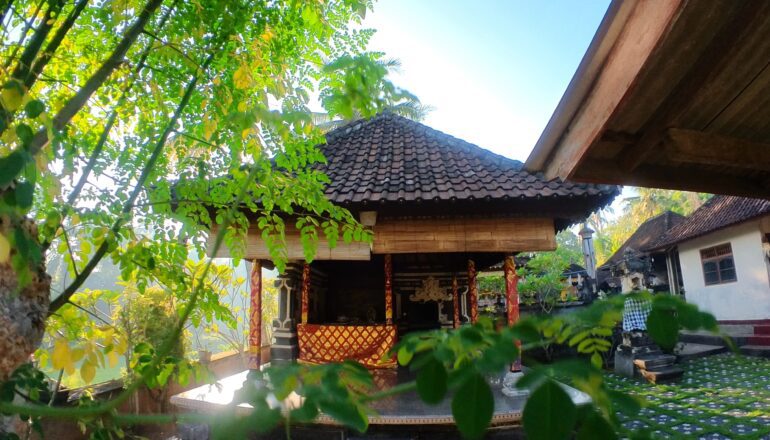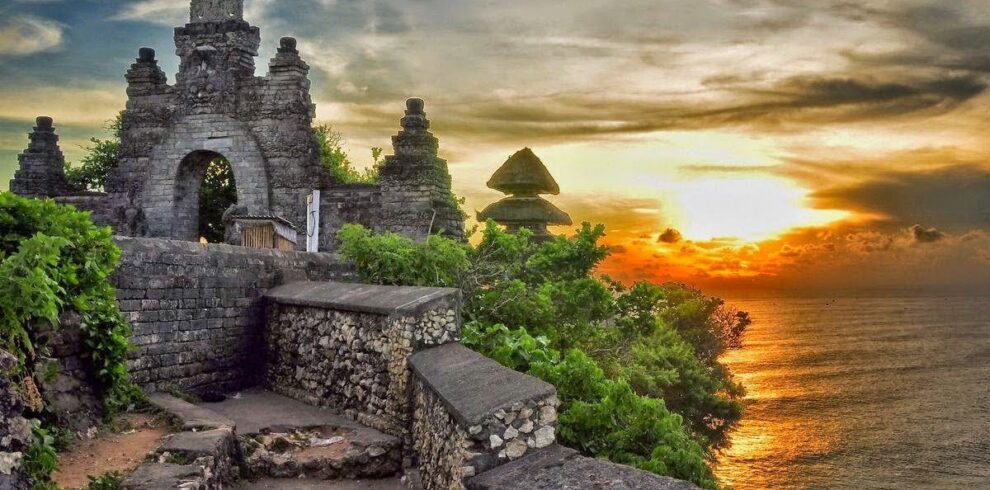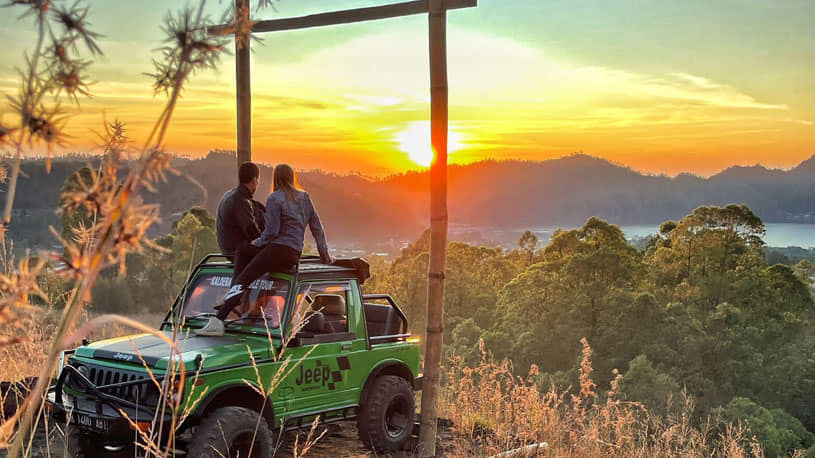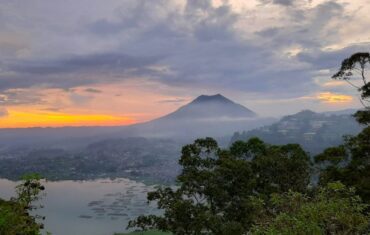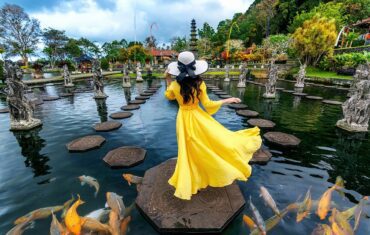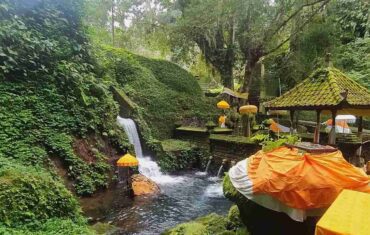Introduction to Padma Bhuwana
Balinese culture always seeks harmony between humans, nature, and the divine. One important system that guides this harmony is called Padma Bhuwana or Padma Buana.
This ancient system helps people understand the universe. It also helps them decide how to arrange temples, homes, and even ceremonies.
The word “Padma” means lotus, a sacred symbol in Hinduism. The word “Bhuwana” means world or universe. So, Padma Bhuwana means “the cosmic lotus of the world.”
Read here: Gunung Kawi Temple: Ancient Royal Tombs in the Heart of Bali
A Sacred Compass for Daily Life
Padma Bhuwana is not only symbolic. It is also practical. It acts like a spiritual compass for the Balinese. It tells them where to build, where to pray, and where to live.
This compass has nine directions, including the center. Each direction is sacred. Each one has a guardian deity, a color, a symbol, and an element.
The Balinese use this system in:
- House and temple design
- Ritual orientation
- Village layouts
- Ceremonial offerings
- Cremation processions
- Temple festivals
So, the Padma Bhuwana system is everywhere in Balinese life.
Understanding the Nine Sacred Directions
Let us now explore the nine directions of Padma Bhuwana. The system works like a lotus flower with eight petals around a center. These directions are:
- East (Kangin)
- West (Kauh)
- North (Kaja)
- South (Kelod)
- Northeast (Kaja-Kangin)
- Northwest (Kaja-Kauh)
- Southeast (Kelod-Kangin)
- Southwest (Kelod-Kauh)
- Center (Pusat)
Each direction has a specific role. The center, for example, is considered the source of all energy.
Now, let’s look at each direction in detail.
The Nine Directions of Padma Bhuwana
1. East (Kangin) – The Direction of New Beginnings
- Deity: Iswara
- Color: White
- Symbol: Purity and Light
- Element: Air
The east represents the sunrise. It symbolizes awakening, purity, and clarity. Many shrines and temple gates face east. Morning prayers are often done in this direction.
2. West (Kauh) – The Direction of Completion
- Deity: Mahadeva
- Color: Black
- Symbol: Closure and Death
- Element: Earth
West is where the sun sets. It stands for endings, meditation, and return to the source. It also connects to ancestors and the afterlife.
3. North (Kaja) – The Sacred Mountain Direction
- Deity: Wisnu (Vishnu)
- Color: Blue
- Symbol: Preservation and Balance
- Element: Water
North represents the mountains and is the most sacred direction. Mount Agung lies to the northeast, and many Balinese temples face this way. It connects the human world to the divine.
4. South (Kelod) – The Direction of the Ocean
- Deity: Brahma
- Color: Red
- Symbol: Creation and Transformation
- Element: Fire
South faces the ocean and the unknown. It stands for life, change, and creativity. Though less sacred, it holds powerful energy.
5. Northeast (Kaja-Kangin) – The Holiest Direction
- Deity: Sambhu or Shiva
- Color: Purple
- Symbol: Spiritual Awakening
This is the most sacred direction. Balinese homes place their family shrine (Sanggah/Merajan) in the northeast corner. The northeast blends purity and divinity.
6. Northwest (Kaja-Kauh)
- Deity: Sangkara
- Color: Orange
- Symbol: Growth and Healing
This direction supports development and spiritual wisdom. It is often used in temples for purification rituals.
7. Southeast (Kelod-Kangin)
- Deity: Mahesora
- Color: Pink
- Symbol: Fertility and Energy
This direction relates to life forces and feminine energy. Offerings and cooking ceremonies may be done here.
8. Southwest (Kelod-Kauh)
- Deity: Rudra
- Color: Dark Green
- Symbol: Protection and Release
This direction is important in funeral rituals. It symbolizes letting go and spiritual liberation.
9. Center (Pusat) – The Cosmic Heart
- Deity: Shiva (as Siwa Raditya)
- Color: Gold or Yellow
- Symbol: Unity and Source of Life
The center is the most important space. It represents harmony and the balance of all energy. In temples, the Padmasana shrine sits in this central location. It honors the Supreme God.
Padma Bhuwana and Tri Hita Karana
Padma Bhuwana aligns beautifully with the Tri Hita Karana concept. This Balinese philosophy promotes harmony in three ways:
- With God (Parahyangan) – through shrines and temple direction
- With People (Pawongan) – through home layout and social structure
- With Nature (Palemahan) – through orientation and land use
By using Padma Bhuwana, the Balinese create spaces that reflect these values.
Application in Daily Life
1. Temple Layout
Balinese temples always follow Padma Bhuwana. The main shrine sits in the kaja-kangin (northeast) part. Gates often open toward the east, letting the sun bless the temple.
2. House Design
Balinese homes also follow this layout. Sacred buildings go in the northeast. Kitchens go in the southeast or southwest. Toilets are built in the south or outer areas.
3. Village Planning
Traditional Balinese villages also use Padma Bhuwana. The pura desa (village temple) usually lies in the kaja direction. The pura dalem (temple of the dead) lies in the kelod area.
4. Ceremonial Processions
Balinese cremation processions (Ngaben) follow these directions. The body is carried from the north (life) to the south (death), representing the soul’s journey.
Cultural Significance
Padma Bhuwana is more than layout. It is also about energy, order, and life flow. The Balinese believe that following this system creates harmony and prevents chaos.
Even today, most traditional homes and temples in Bali use Padma Bhuwana. Architects, priests, and community leaders consult it for every project.
Comparing Padma Bhuwana to Other Systems
Many ancient cultures had spatial systems. For example:
- Chinese Feng Shui focuses on energy flow and directions
- Indian Vastu Shastra aligns homes with cosmic elements
- Western Sacred Geometry uses forms to reflect spiritual truths
Padma Bhuwana is Bali’s own unique version. However, it shares one key belief: space affects life.
Challenges and Modern Adaptations
Today, urban development has changed how Balinese people live. Limited land, tourism, and modern buildings often ignore Padma Bhuwana.
However, some architects combine traditional layouts with modern needs. Villas, eco-resorts, and cultural centers now bring this wisdom into modern spaces.
Also, Balinese schools and colleges teach this system to future generations. Cultural pride and tourism both help preserve it.
Why Tourists Should Understand Padma Bhuwana
When you visit Bali, you may enter temples, homes, and resorts designed with Padma Bhuwana. You might wonder why the family shrine always lies in the northeast. Or why pavilions face certain ways.
Understanding this system gives you deeper respect for Balinese culture. You realize that every direction has meaning. Every structure follows spiritual law.
Your trip becomes not just relaxing, but also enriching.
Conclusion: Living in Cosmic Balance
In conclusion, Padma Bhuwana offers the Balinese people a map to live in harmony with the universe. It brings structure, peace, and spirituality into daily life.
Though ancient, this system still thrives. It helps shape temples, homes, ceremonies, and even villages.
Balinese people do not just live on land. They live within the cosmos, guided by a lotus of light, meaning, and purpose.
By honoring Padma Bhuwana, they honor the Earth, the gods, and each other.
Read here: Besakih Temple Bali: The Complete Guide to Bali’s Mother Temple
The Best Trip Destination
Bali, Indonesia, beckons with its diverse allure. Explore Ubud’s cultural treasures, witness the iconic Tanah Lot Temple at sunset, and surf the waves of Kuta Beach. Discover the scenic beauty of Tegallalang Rice Terraces and embrace the lively atmosphere of Seminyak. Dive into the underwater wonders of Amed, relax on the pristine shores of Nusa Dua, and wander through ancient temples in the heart of Bali. Whether seeking vibrant nightlife, serene landscapes, or cultural richness, Bali’s enchanting destinations cater to every traveler’s desire.
Ubud (14 Trips)
Eastern Bali (7 Trips)
Southern Bali (5 Trips)
Northern Bali (5 Trips)
Nusa Penida Island (4 Trips)
Western Bali (4 Trips)
The Best Activities In Bali
Indulge in Bali’s diverse activities, from surfing the waves in Kuta to exploring cultural treasures in Ubud. Snorkel vibrant coral reefs in Amed, trek lush rice terraces, and rejuvenate in serene spa retreats. Dive into the lively nightlife of Seminyak, witness traditional dance performances, and sample local delicacies in bustling markets. Whether it’s hiking Mount Batur for a sunrise vista or embracing the spiritual ambiance of ancient temples, Bali offers a kaleidoscope of experiences for every traveler’s passion.

